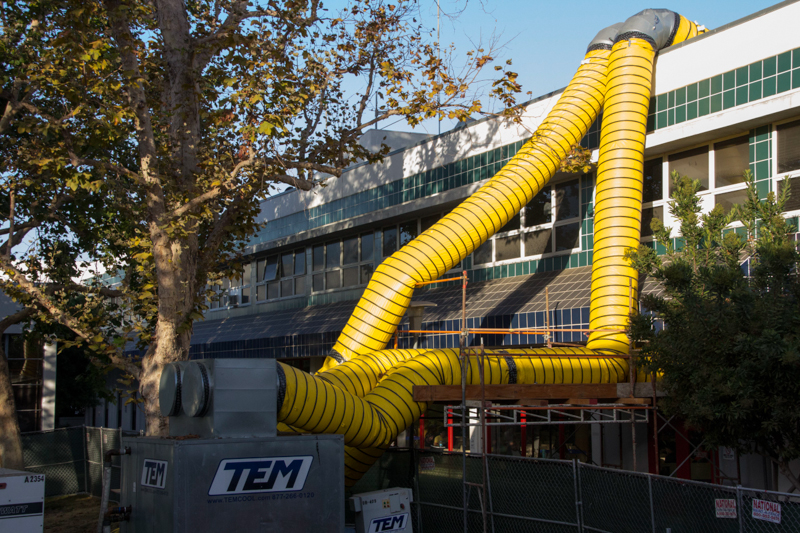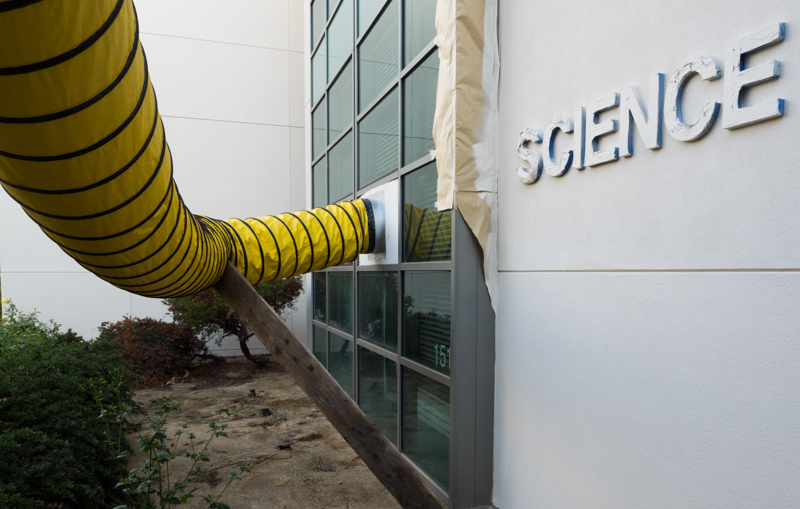What Are Those Yellow Tubes on Campus?
What Are Those Yellow Tubes On Campus?
The Santa Monica College community was greeted on its return to Main Campus for the Fall 2016 Semester with the appearance of giant yellow tubes coming from around the Clock Tower and snaking into the Science Complex, Liberal Arts, Letters and Science and Cafteria buildings.
Photo by: Cliff Cheng
Bright yellow, they snake through the quad, climbing up buildings, through hallways and into windows. However, looking around the quad, one sees that the surprise of these fabric funnels doesn’t take long to wear off as they are quickly accepted as a normal part of life here on Santa Monica College. So what are all these mustard colored tentacles doing on campus? Where are they from and what do they want from us?
These slithering yellow tendrils are actually air conditioning tubes intended to alleviate the scorching hot buildings. They have been contracted from July through the end of October at the price tag of about $1.2 million.
The buildings were originally designed to use the ocean breeze to cool themselves. “Traditionally [in] a coastal city like this, it is very common to not have air conditioned buildings,”said Director of Facilities Management, Bruce Wyban. “For the last ten years or so a lot of people have noticed the climate seems to be changing.”
Yellow air conditioning tube enters building at Santa Monica College.
Photo by: Andrew Aono
Another teacher, who asked not to be named, also credits the changing climate with making the sea breeze cooling system ineffective. “You know, when they designed this building we were supposed to have the ocean breeze as normal weather but now we have so much more hot humid weather that it quit working. The climate has changed so much that now it’s just intolerable,” she said.
“Last year at this time we tried an experiment to try to alleviate some of these conditions,” said Wyban. This “experiment” was a smaller scale version of these peculiar golden pipelines confined to the counseling complex. Upon receiving positive feedback about the temporary air conditioning system, Wyban decided to implement it this year on a larger scale in the buildings surrounding the clock tower quad.
As Wyban calls this temporary solution a “relatively successful effort,” others disagree. “It doesn’t seem to be working,” said one staff member who chose to remain nameless. “We call them ‘the octopus.’ They’re disgusting,” she said while pointing to the desk fans throughout the room as the twisting yellow tubes loomed outside her window, obscuring her view of the quad.
The tubes, which are relatively few in number for the amount of space they have to service, must be placed selectively. But this means that some staff members still have to endure the heat, as priority is given to areas with larger amounts of students. In some areas, where the tubes cannot service every classroom individually, they instead pump air into the hallways via tubes of thin white plastic.
“I’ve always wondered [what they were], I just thought it was ventilation. I hope it’s on and if it is on I never feel anything. It’s always kind of hot,” said Josh Chacon, an SMC student.
According to one professor who teaches in a room at the end of one of these tubes, she hasn’t had a problem yet. However, while in the Science building, “I was freezing and it was drying my eyes out,” she said.
Yellow air conditioning tubes enter a classroom of the Life Science building.
Photo by: Andrew Aono
According to Wyban, a permanent air conditioning solution for the buildings where the tubes run would cost about $11 million. Part of the reason for the high costs of a permanent air conditioning solution is due to the structural and electrical inadequacy of the buildings.
“The mechanical equipment it takes to air condition a building of that size would have to go on the roof and those roofs are not designed to handle that weight, so that’s part of the reason for the cost,” said Carl Sheaffer, Assistant Director of Facilities Management. Additionally, he notes that the electrical capacity of these older buildings is low and that this too would need updating before permanent air conditioning could be implemented.
The school now waits on bond measures which would grant the funding necessary to tear down the old buildings and construct new ones. So while the presence of these yellow monsters are temporary, we might be seeing them again in years to come.
Editor's note: This post was edited after publication to fix grammatical errors. The content of the story was not altered.
Photo by: Cliff Cheng




